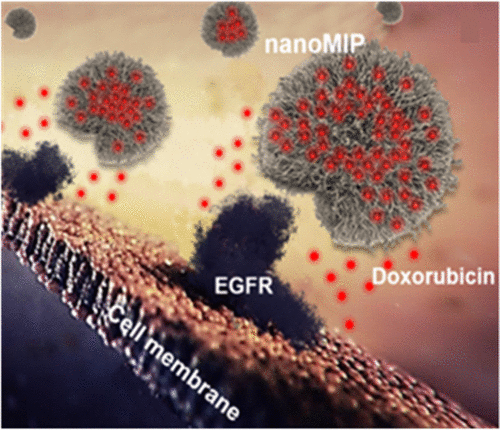当前位置:
X-MOL 学术
›
Nano Lett.
›
论文详情
Our official English website, www.x-mol.net, welcomes your
feedback! (Note: you will need to create a separate account there.)
Specific Drug Delivery to Cancer Cells with Double-Imprinted Nanoparticles against Epidermal Growth Factor Receptor
Nano Letters ( IF 9.6 ) Pub Date : 2018-07-03 00:00:00 , DOI: 10.1021/acs.nanolett.7b03206 Francesco Canfarotta 1 , Larissa Lezina 2 , António Guerreiro 1 , Joanna Czulak 1 , Alexey Petukhov 2, 3 , Alexandra Daks 2 , Katarzyna Smolinska-Kempisty , Alessandro Poma 4 , Sergey Piletsky , Nickolai A Barlev 2, 5
Nano Letters ( IF 9.6 ) Pub Date : 2018-07-03 00:00:00 , DOI: 10.1021/acs.nanolett.7b03206 Francesco Canfarotta 1 , Larissa Lezina 2 , António Guerreiro 1 , Joanna Czulak 1 , Alexey Petukhov 2, 3 , Alexandra Daks 2 , Katarzyna Smolinska-Kempisty , Alessandro Poma 4 , Sergey Piletsky , Nickolai A Barlev 2, 5
Affiliation

|
Epidermal growth factor receptor (EGFR), a tyrosine kinase receptor, is over-expressed in many tumors, including almost half of triple-negative breast cancers. The latter belong to a very-aggressive and drug-resistant form of malignancy. Although humanized anti-EGFR antibodies can work efficiently against these cancers both as monotherapy and in combination with genotoxic drugs, instability and high production costs are some of their known drawbacks in clinical use. In addition, the development of antibodies to target membrane proteins is a very challenging task. Accordingly, the main focus of the present work is the design of supramolecular agents for the targeting of membrane proteins in cancer cells and, hence, more-specific drug delivery. These were produced using a novel double-imprinting approach based on the solid-phase method for preparation of molecularly imprinted polymer nanoparticles (nanoMIPs), which were loaded with doxorubicin and targeted toward a linear epitope of EGFR. Additionally, upon binding, doxorubicin-loaded anti-EGFR nanoMIPs elicited cytotoxicity and apoptosis only in those cells that over-expressed EGFR. Thus, this approach can provide a plausible alternative to conventional antibodies and sets up a new paradigm for the therapeutic application of this class of materials against clinically relevant targets. Furthermore, nanoMIPs can promote the development of cell imaging tools against difficult targets such as membrane proteins.
中文翻译:

具有针对表皮生长因子受体的双印迹纳米颗粒向癌细胞的特异性药物递送
表皮生长因子受体 (EGFR) 是一种酪氨酸激酶受体,在许多肿瘤中过度表达,包括几乎一半的三阴性乳腺癌。后者属于一种非常具有侵袭性和耐药性的恶性肿瘤。尽管人源化抗 EGFR 抗体作为单一疗法和与基因毒性药物联合使用都可以有效对抗这些癌症,但不稳定性和高生产成本是它们在临床使用中的一些已知缺点。此外,针对靶膜蛋白的抗体的开发是一项非常具有挑战性的任务。因此,目前工作的主要重点是设计用于靶向癌细胞中膜蛋白的超分子药物,从而实现更特异性的药物递送。这些是使用基于固相法制备分子印迹聚合物纳米粒子 (nanoMIP) 的新型双印迹方法生产的,该纳米粒子负载多柔比星并靶向 EGFR 的线性表位。此外,在结合后,负载多柔比星的抗 EGFR nanoMIP 仅在过度表达 EGFR 的细胞中引发细胞毒性和细胞凋亡。因此,这种方法可以为传统抗体提供一种合理的替代方案,并为此类材料针对临床相关靶点的治疗应用建立新的范例。此外,nanoMIPs 可以促进细胞成像工具的发展,以对抗膜蛋白等困难目标。载有阿霉素并靶向EGFR的线性表位。此外,在结合后,负载多柔比星的抗 EGFR nanoMIP 仅在过度表达 EGFR 的细胞中引发细胞毒性和细胞凋亡。因此,这种方法可以为传统抗体提供一种合理的替代方案,并为此类材料针对临床相关靶点的治疗应用建立新的范例。此外,nanoMIPs 可以促进细胞成像工具的发展,以对抗膜蛋白等困难目标。载有阿霉素并靶向EGFR的线性表位。此外,在结合后,负载多柔比星的抗 EGFR nanoMIP 仅在过度表达 EGFR 的细胞中引发细胞毒性和细胞凋亡。因此,这种方法可以为传统抗体提供一种合理的替代方案,并为此类材料针对临床相关靶点的治疗应用建立新的范例。此外,nanoMIPs 可以促进细胞成像工具的发展,以对抗膜蛋白等困难目标。这种方法可以为传统抗体提供一种合理的替代方案,并为此类材料针对临床相关靶点的治疗应用建立了新的范例。此外,nanoMIPs 可以促进细胞成像工具的发展,以对抗膜蛋白等困难目标。这种方法可以为传统抗体提供一种合理的替代方案,并为此类材料针对临床相关靶点的治疗应用建立了新的范例。此外,nanoMIPs 可以促进细胞成像工具的发展,以对抗膜蛋白等困难目标。
更新日期:2018-07-03
中文翻译:

具有针对表皮生长因子受体的双印迹纳米颗粒向癌细胞的特异性药物递送
表皮生长因子受体 (EGFR) 是一种酪氨酸激酶受体,在许多肿瘤中过度表达,包括几乎一半的三阴性乳腺癌。后者属于一种非常具有侵袭性和耐药性的恶性肿瘤。尽管人源化抗 EGFR 抗体作为单一疗法和与基因毒性药物联合使用都可以有效对抗这些癌症,但不稳定性和高生产成本是它们在临床使用中的一些已知缺点。此外,针对靶膜蛋白的抗体的开发是一项非常具有挑战性的任务。因此,目前工作的主要重点是设计用于靶向癌细胞中膜蛋白的超分子药物,从而实现更特异性的药物递送。这些是使用基于固相法制备分子印迹聚合物纳米粒子 (nanoMIP) 的新型双印迹方法生产的,该纳米粒子负载多柔比星并靶向 EGFR 的线性表位。此外,在结合后,负载多柔比星的抗 EGFR nanoMIP 仅在过度表达 EGFR 的细胞中引发细胞毒性和细胞凋亡。因此,这种方法可以为传统抗体提供一种合理的替代方案,并为此类材料针对临床相关靶点的治疗应用建立新的范例。此外,nanoMIPs 可以促进细胞成像工具的发展,以对抗膜蛋白等困难目标。载有阿霉素并靶向EGFR的线性表位。此外,在结合后,负载多柔比星的抗 EGFR nanoMIP 仅在过度表达 EGFR 的细胞中引发细胞毒性和细胞凋亡。因此,这种方法可以为传统抗体提供一种合理的替代方案,并为此类材料针对临床相关靶点的治疗应用建立新的范例。此外,nanoMIPs 可以促进细胞成像工具的发展,以对抗膜蛋白等困难目标。载有阿霉素并靶向EGFR的线性表位。此外,在结合后,负载多柔比星的抗 EGFR nanoMIP 仅在过度表达 EGFR 的细胞中引发细胞毒性和细胞凋亡。因此,这种方法可以为传统抗体提供一种合理的替代方案,并为此类材料针对临床相关靶点的治疗应用建立新的范例。此外,nanoMIPs 可以促进细胞成像工具的发展,以对抗膜蛋白等困难目标。这种方法可以为传统抗体提供一种合理的替代方案,并为此类材料针对临床相关靶点的治疗应用建立了新的范例。此外,nanoMIPs 可以促进细胞成像工具的发展,以对抗膜蛋白等困难目标。这种方法可以为传统抗体提供一种合理的替代方案,并为此类材料针对临床相关靶点的治疗应用建立了新的范例。此外,nanoMIPs 可以促进细胞成像工具的发展,以对抗膜蛋白等困难目标。











































 京公网安备 11010802027423号
京公网安备 11010802027423号